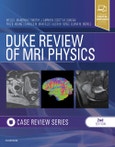A solid understanding of MRI physics is essential for both residents and practicing radiologists, and Duke Review of MRI Physics Principles: Case Review Series, 2nd Edition, provides practical applications, board-style self-assessment questions, and clinically relevant cases in a high-yield, easy-to-digest format. Designed to help you solve clinical questions, arrive at accurate diagnoses, and use MRI more effectively in your practice, it uses a case-based approach to demonstrate the basic physics of MRI and how it applies to successful and accurate imaging, interpretation, and diagnosis.
- Focuses on 18 key MRI principles (such as T1 contrast, T2 contrast, and proton density), using a series of cases that make difficult concepts engaging and understandable.
- Features over 800 high-quality MR images in a full-color, user-friendly case format with clear explanations of physics and other MRI principles. - Shares the experience and knowledge of a multidisciplinary author team comprising radiology residents, practicing radiologists, and radiology physicists who provide practical guidance for each body system - neurologic, breast, body, vascular, and musculoskeletal. - Includes a new chapter on MRI Safety, as well as new and improved color images in functional MRI, perfusion MRI, and diffusion tensor imaging.
- Contains more than 300 all-new multiple-choice self-assessment questions following the board review certification and recertification question format.
- Includes new Take-Home-Points at the end of each chapter for easy recall and review.
- Expert ConsultT eBook version included with purchase. This enhanced eBook experience allows you to search all of the text, figures, and references from the book on a variety of devices.
- Focuses on 18 key MRI principles (such as T1 contrast, T2 contrast, and proton density), using a series of cases that make difficult concepts engaging and understandable.
- Features over 800 high-quality MR images in a full-color, user-friendly case format with clear explanations of physics and other MRI principles. - Shares the experience and knowledge of a multidisciplinary author team comprising radiology residents, practicing radiologists, and radiology physicists who provide practical guidance for each body system - neurologic, breast, body, vascular, and musculoskeletal. - Includes a new chapter on MRI Safety, as well as new and improved color images in functional MRI, perfusion MRI, and diffusion tensor imaging.
- Contains more than 300 all-new multiple-choice self-assessment questions following the board review certification and recertification question format.
- Includes new Take-Home-Points at the end of each chapter for easy recall and review.
- Expert ConsultT eBook version included with purchase. This enhanced eBook experience allows you to search all of the text, figures, and references from the book on a variety of devices.
Table of Contents
1. T1 Contrast2. T2 Contrast
3. Proton Density
4. Gadolinium-Based Contrast Agents
5. Preparatory Pulses
6. Inversion Recovery
7. Chemical Shift Type 2 Artifact
8. Susceptibility Artifact
9. Motion, Pulsation, and Other Artifacts
10. Flow-Related Contrast
11. Time-of-Flight Imaging
12. Time-Resolved Contrast-Enhanced Magnetic Resonance Angiography
13. Phase Contrast
14. Diffusion MRI
15. Perfusion Magnetic Resonance Imaging
16. Magnetic Resonance Spectroscopy
17. Functional Magnetic Resonance Imaging
18. MRI Safety








